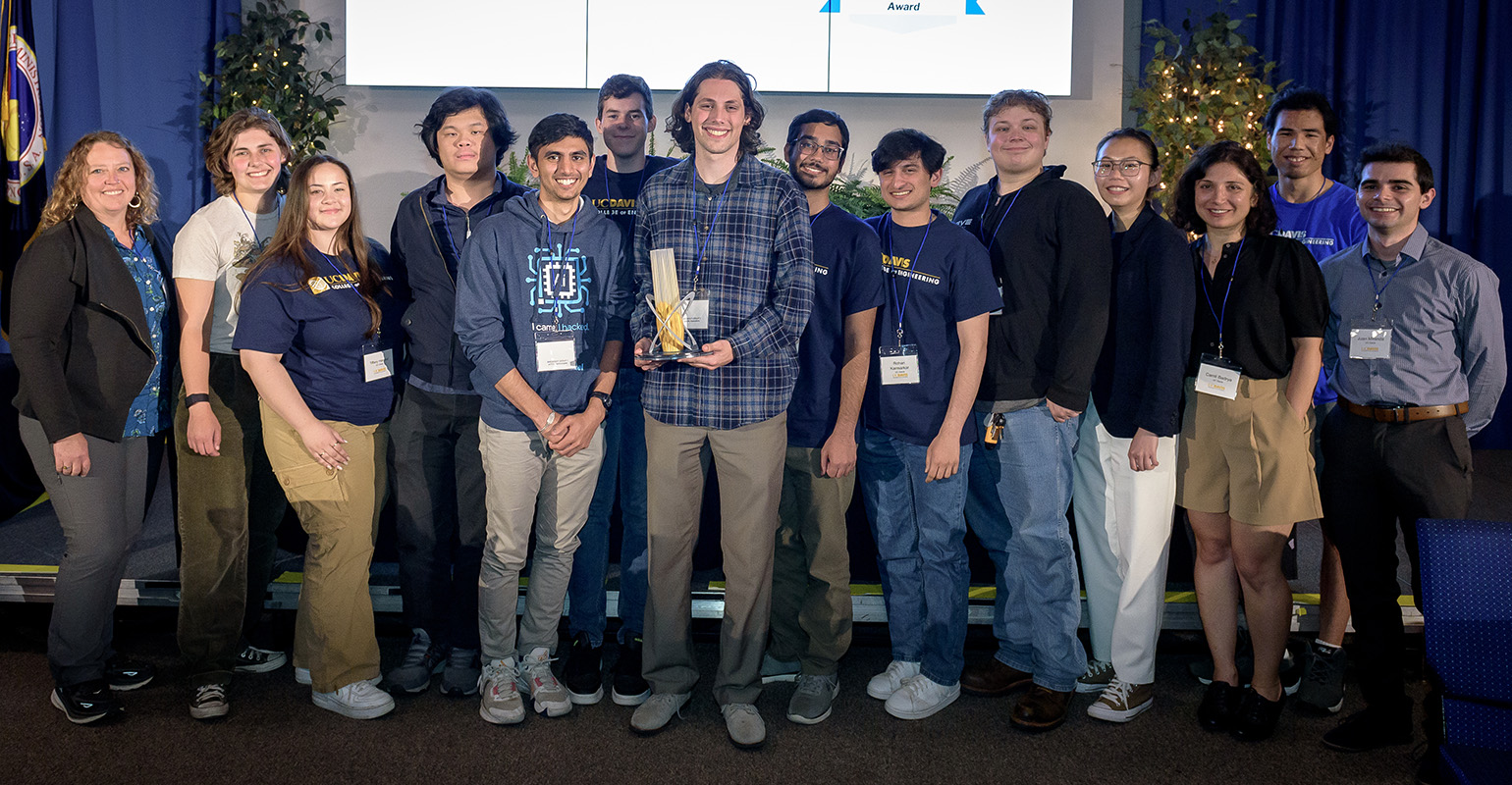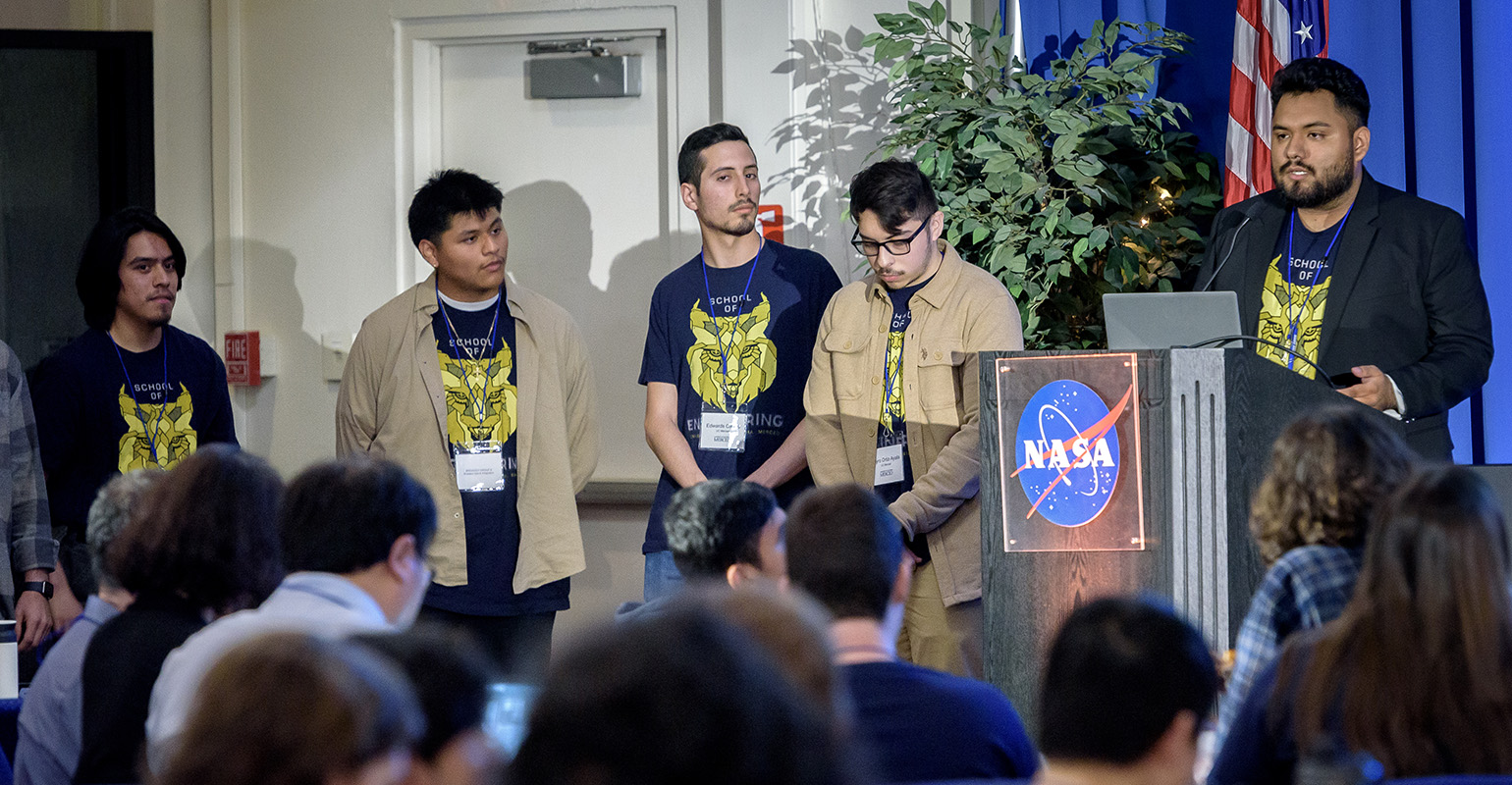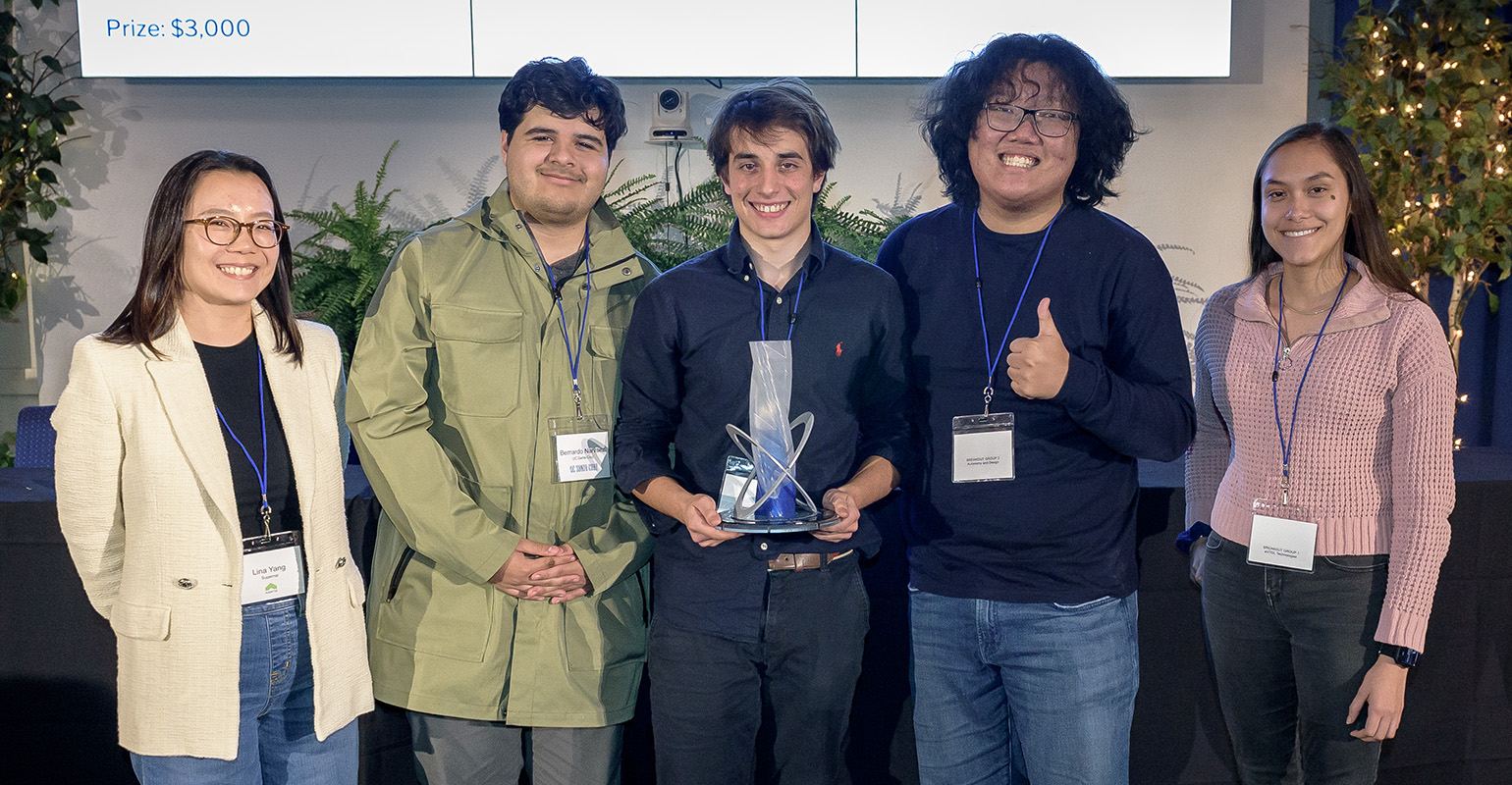A bustling crowd of aviation experts celebrated hard-working student teams from four UC campuses as CITRIS and the Banatao Institute presented more than $10,000 in industry-sponsored awards.
What would it take to connect the University of California’s campuses in Berkeley, Davis, Merced and Santa Cruz with a safe and sustainable system of air taxis, equipped to ferry students, faculty, staff and cargo across Northern California?
That’s the question posed by the 2023–24 CITRIS Aviation Prize, the student design competition organized by CITRIS Aviation, a research initiative of the multicampus, interdisciplinary Center for Information Technology Research in the Interest of Society and the Banatao Institute (CITRIS) at the University of California (UC).
The contest reached its greatest heights on Monday, April 29, when the four top-scoring teams from the first phase of the competition presented their final proposals to a panel of academic and industry judges at the NASA Ames Research Center in Mountain View, during a NASA-UC urban air mobility (UAM) technical summit. Up for grabs was $13,500 in award money, sponsored by Joby Aviation, Lenovo, Supernal, and the Monterey Bay Drone, Automation and Robotics Technologies (DART) Initiative.
“I am very excited about the cooperation between the UC, NASA and the private sector in organizing and judging this prize,” said CITRIS Director Alexandre Bayen, Liao-Cho Innovation Endowed Chair and professor of electrical engineering and computer sciences and of civil and environmental engineering at UC Berkeley, and associate provost for the Berkeley Space Center. “This collaboration exemplifies the partnerships we will establish at the Berkeley Space Center.
“While this first aviation summit was an opportunity to illustrate the partnerships in the context of the CITRIS Aviation Prize, we look forward to building more ambitious connections around R&D projects,” said Bayen.

This year, the second iteration of the competition challenged student teams to develop detailed designs for air mobility infrastructure that could serve as the basis for a campus-to-campus transportation system for the University of California.
“We architected this edition of the prize to identify opportunities and challenges for the future of air mobility,” said CITRIS Aviation Director Ricardo Sanfelice, chair of the UC Santa Cruz Department of Electrical and Computer Engineering.
“Each team generated innovative conceptual designs that are properly tailored to the local needs, yet are connectable to the other campuses,” he said. “These are key initial insights for what it would take for the University of California to be connected by air.”
Combining imagination with engineering analysis and design
The following teams presented their proposals in Mountain View:
- UC Berkeley
- Team members: Jordan Kam, Rain Luo, Leire Roma Rubi, Ting-Hao Wang, Kaiqi Yang, Xi Zheng, Enyang Zou; adviser: Mark Mueller, associate professor of mechanical engineering
- UC Davis
- Team members: Gabriel Darrett, Tiffany Harrend, Joshua Jacobs, Harsh Karia, Rohan Karmarkar, Jordan King, Christian Martell, Lucian Nguyen, Madison Nickels, Abid Vahanvaty, Ziheng Xu; adviser: Camli Badrya, assistant professor of mechanical and aerospace engineering
- UC Merced
- Team members: Edwards Castro, Jason Estevez, Juan Estrada, Rafal Krzysiak, Jayro Ortiz-Ayala, Alan Ramirez, Ivan Flores Vargas; adviser: Francesco Danzi, assistant professor of mechanical engineering
- UC Santa Cruz
- Team members: Alexander Aghili, Albert Lee, Natalie Gutierrez Moncada, Bernardo Narvaez; adviser: Tyler Sorensen, assistant professor of computer science and engineering
The UC Berkeley team, which featured two undergraduate students, four students in the Master of Engineering (MEng) program and one doctoral student, received the Joby Aviation Award for Best Overall Design, worth $3,000, as well as the $1,500 CITRIS Aviation Excellence Award.

The all-undergraduate UC Davis team received the two $3,000 awards sponsored by Lenovo: one for excellence in air mobility innovation and another for sustainability. The UC Santa Cruz team, also comprised entirely of undergraduates, won the $3,000 Supernal Award for Most Innovative Design for Air Mobility.
Collaborating to ‘create a better tomorrow’
For the final stage of the two-part competition, the top-scoring student teams from each of the four participating campuses were asked to expand upon their initial three-page proposals, which presented a vision for a state-of-the-art air mobility system for their home campus.
The technology needed to be at least three times faster than ground transportation, easy to connect to other UC campuses and deployable within the next five years — at least in theory. The contest requirements stressed energy efficiency and cost-effectiveness in the designs, as well as sustainability and minimal environmental impact.
“When I came into the competition, I wanted to be conservative with our proposal,” said Albert Lee, co-lead of the UC Santa Cruz team and president of the Slugbotics student robotics club. “We needed to bring in all the details to get it built in five years — nothing fancy.
“However, after seeing all of the amazing research being done, I think that technical innovation is crucial to the movement of this field. If this competition were to happen again, I’d say to go wild with your ideas, because that’s what’s going to convince people to invest in them.”

The contest saw many students venturing out of their academic comfort zones and picking up leadership skills that will benefit them in the workplace. Jerry Yang, an MEng student at UC Berkeley, said his biggest takeaways were learning to manage time conflicts with his teammates and mentors, and learning to ask for help.
“We are from mechanical engineering and civil engineering backgrounds, so we had to do a lot of research on aviation and airspace,” Yang said. “We had to contact professors in aerospace engineering and transportation engineering to ask them about aerospace problems and regulations.”
Jordan King, a UC Davis undergraduate and his team’s student lead, agreed on those lessons learned. “There were definitely a lot of moving pieces!” he said. “We relied on a strong support network of faculty on campus and a lot of research on our own.
“This was one of the first opportunities I’ve had to be a leader for something like this,” he said. “All of us will walk away with valuable skills, when it comes to applying the knowledge we learned in school to a real-world setting.”
Jayro Ortiz-Ayala, one of six undergraduates on UC Merced’s seven-person team, particularly appreciated the connections he made, from faculty on his home campus all the way through the judges of the final presentations.
“When the competition was coming to a close, we got to meet many people at CITRIS, Joby, NASA and other industry partners,” said Ortiz-Ayala. “This, above all, is what the point is for us: working together to create a better tomorrow.”
Standing on the brink of ‘profound transformation’
Representatives from the CITRIS Aviation Prize’s sponsors, many of whom also served as judges, reported finding renewed motivation in the contest’s mission to inspire future research and business leaders to innovate on ambitious, real-world aviation issues.

“The competition enables universities and industries to align and collaborate on concrete problems of today and tomorrow,” said Christabelle Bosson, a staff airspace engineer at Joby Aviation. “Building an innovative sustainable urban air transportation is not an easy task — these types of challenges enable students to think through many different aspects that contribute to building an efficient solution.”
The delegate from Lenovo highlighted that his organization took an opportunity to cultivate an area of great importance to its own mission with its award for sustainable innovation.
“Sustainability is the core tenet of Lenovo’s vision and strategy,” said Munan Singhal, chief of staff for Lenovo’s vice president and general manager of edge computing and telecommunications. “While Lenovo is leading the way in a collaborative and accountable journey to net-zero, it is also committed to help its customers on their journey to a low-carbon future.”
Several industry representatives were notably impressed by the quality of the students’ proposals and performances, describing their efforts as “enriching,” “impressive” and thought-provoking.
“The work from the undergraduate students amazed me!” said Lina Yang, head of intelligent systems at Supernal. “It was truly surprising to witness their ability to understand the urban air mobility ecosystem within such a brief timeframe.
“I strongly support CITRIS Aviation’s vision statement,” she said. “We stand at the brink of profound transformation, and initiatives such as the CITRIS competition are crucial for integrating and elevating education to equip individuals with the requisite skill sets for industry success.”

